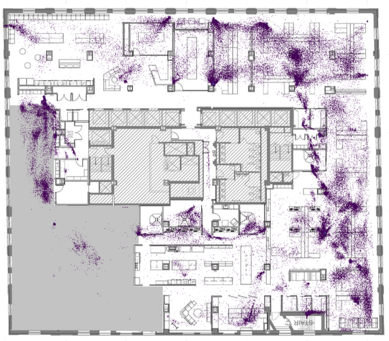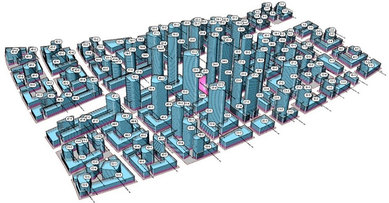Evolve Or Perish: Data-Driven Design Tools Are Changing The Game

This article was previously published in Work Design Magazine.
The profession of architecture has undergone radical transformation over the past 25 years due to advancements in technology. In 2005, Tom Mayne of Morphosis urged an audience at the AIA National Convention to “change or perish.” He was referring to the importance of BIM as a game-changing technology for the practice of architecture. His words were embraced by a few early adopters, while the rest of the profession followed, kicking and screaming, after having only just survived the transition from hand drafting to CAD.
Today, we find ourselves in the next wave. Simulation, computational design, and data analytics are the profession’s new “change or perish.” This data-driven wave brings us a new set of criteria and sense of urgency to change and adapt to maintain relevance. Architects, engineers, and designers need to embrace these new technologies and offer a new set of services in order to keep up.
A VERY BRIEF HISTORY OF ARCHITECTURAL DISRUPTION
The transition from drafting to CAD swapped out one two-dimensional process for another two-dimensional process. This paradigm shift was simple and clear and did not deviate from the 2D world. With the introduction and transition to BIM, designers were able to move beyond 2D. BIM allowed designers to use smart objects, simulating buildings and sites, and considering effects of time and a host of other forces on the virtual design. Today, designers are equipped with data and tools to leverage information thanks to their increasing accessibility. As the profession once transitioned from one 2D process to another 2D process, we are presented today with the ability to swap out one data machine (i.e. BIM) for a network of data machines.
INCREASING PRESSURE TO MEASURE
Gone are the days where cost per square foot, kilowatts per square foot and first costs are metrics of success. Clients are now much savvier and have a new set of metrics. For example, as our clients seek to attract and retain the best talent, we need tools that measure human preference and behavior. As our clients hope to have a healthy workplace, we need to understand how space, light and other environmental factors contribute to wellness. As architects and engineers leverage this network of data machines, we can solve these more complex problems and measurements of success for our clients. We can harness and pass data between applications in ways that were not previously possible. Combined with advancements in visualization, data enables a powerful approach to design that doesn’t resemble the suite of services designers offered to their client only a few years ago.
In the following sections, I expand upon several perspectives that SmithGroup has adopted to better utilize data sources and meet our clients’ goals.
UTILIZING DATA IN PRACTICE
Office environments are driven by a new set of performance metrics with emphasis on people. It’s important to understand the impact of design decisions on the quality of the space. Is the design encouraging wellness and improving engagement? These metrics, along with many others, focus on how design can impact our clients’ business goals.
In our Chicago office, our post-occupancy studies included tracking staff movements via sensors. The information gleaned helped us to better understand where gathering was occurring, which set-ups in the agile office were most popular, and conference room utilization.


SmithGroup is participating in a year-long COGfx study which is being conducted by Harvard’s T.H. Chan School of Public Health Healthy Building Program. COGfx is studying buildings all over the world to determine what factors contribute to healthy work environments. The intent is to help all stakeholders – building managers, architects, engineers, interior designers, and developers create healthy work environments. The study uses an smartphone app and wearable device (think Fitbit tracking sleep, steps, heartbeat) in combination with environmental sensors to monitor dust, TVOC’s (total volatile organic compounds), CO2, temperature, ambient light, and noise. Surveys are also a major part of the study. SmithGroup’s Boston and San Francisco offices each have 10 participants enrolled as part of an ongoing effort by SmithGroup’s Technology in Practice Data Solutions Group to better understand how we shape and are shaped by our work environments.
Computational design solutions, like Rhino + Grasshopper, Dynamo + Revit, allow designers to go from geometry to automated 2D documents. They enable designers to measure and predict building performance and human factors. Custom scripts analyze and measure all of the data we can input, and the input process doesn’t require a computer science degree. It’s a new and exciting way to think about design.
Using augmented reality in the field to verify panel placement on the new DC Water Headquarters in Washington, DC. The windows and metal panel tags from the Revit model are “mapped” onto the façade of the building, allowing the design team to verify the proper panels were installed by the contractor.

At the city scale, data-driven solution use scripting in combination with a CAD background to develop density scenarios based on parameters established by the design team (i.e. floor area ratios, height, setbacks, etc.). This allows the team to rapidly prototype entire city blocks to meet design requirements. The resulting data can be reported in a number of ways – graphically, spreadsheets, etc.

THE QUEST TO REMAIN RELEVANT
Remaining relevant as design professionals requires us to embrace new service offerings, new tools and data-driven workflows. With disruption driving changes in space utilization and the pressures of talent acquisition and retention, our clients rely on us more and more to understand and measure all factors that influence design quality, including the human factors. As a profession, our teams need to be well-versed in managing data from start to finish. We need to embrace these new set of metrics and services and continue to employ data as a key component to design.
